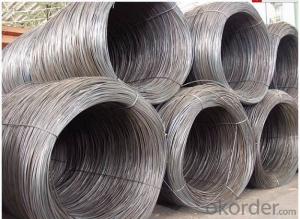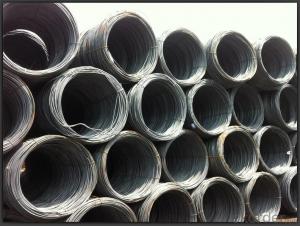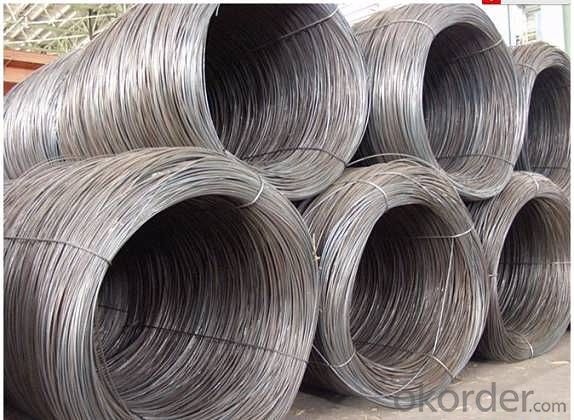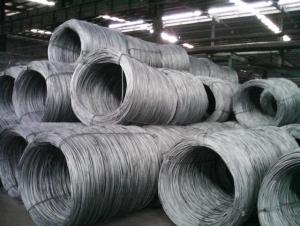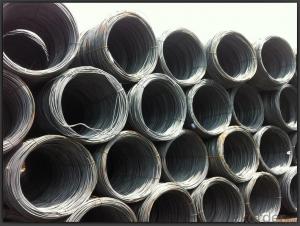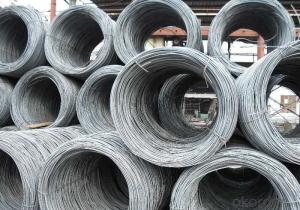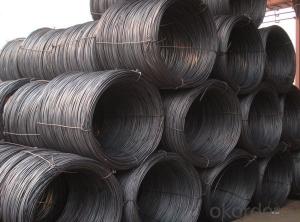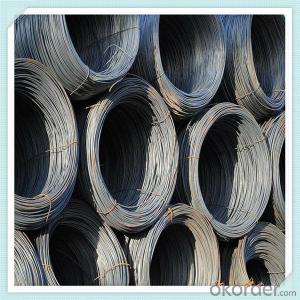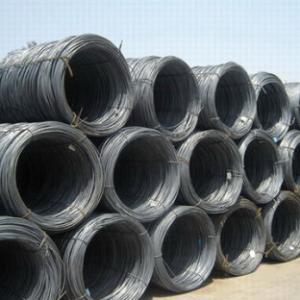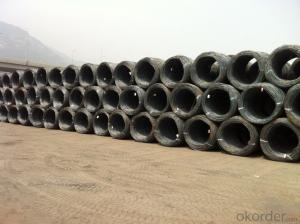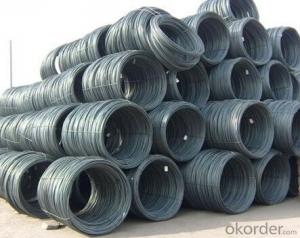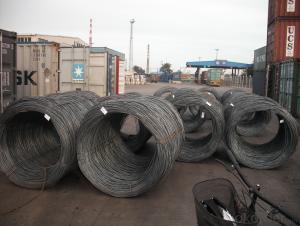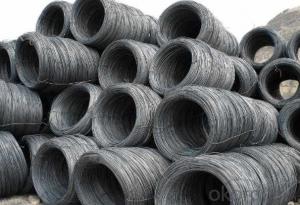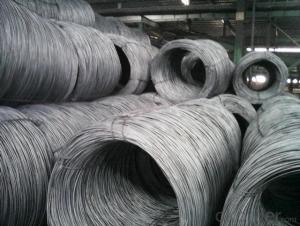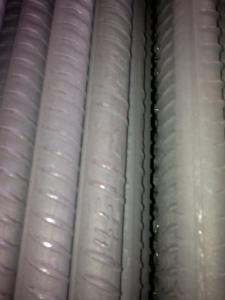Hot Rolled Steel Wire Rod SAE1006 ou Q235 5.5MM-14MM
- Loading Port:
- Tianjin
- Payment Terms:
- TT or LC
- Min Order Qty:
- 25 m.t.
- Supply Capability:
- 100000 m.t./month
OKorder Service Pledge
OKorder Financial Service
You Might Also Like
Product Description:
OKorder is offering Hot Rolled Steel Wire Rod SAE1006 ou Q235 5.5MM-14MM at great prices with worldwide shipping. Our supplier is a world-class manufacturer of steel, with our products utilized the world over. OKorder annually supplies products to European, North American and Asian markets. We provide quotations within 24 hours of receiving an inquiry and guarantee competitive prices.
Product Applications:
After hot-rolled the products shaped into coil and delivery as finished product, including round, square, rectangular, hexagonal and so on. Since most of the products are round, it is generally called wire rod. Carbon steel wire rod is widely used in construction and manufacturing. Carbon steel wire rod is mainly used for reinforcement of reinforced concrete and welded structure or reprocessed (roberts , nail, etc.) materials, especially used to produce wire drawing, welding electrode, nails, spring, electronic, precise machinery parts and so on.
Product Advantages:
OKorder's Hot Rolled Steel Wire Rod SAE1006 ou Q235 5.5MM-14MM are durable, strong, and resist corrosion.
Main Product Features:
· Premium quality
· Prompt delivery & seaworthy packing (30 days after receiving deposit)
· Corrosion resistance
· Can be recycled and reused
· Mill test certification
· Professional Service
· Competitive pricing
Product Specifications:
Manufacture: Hot rolled
Grade: SAE1008 SAE 1006
Certificates: ISO, SGS, BV, CIQ
Diameter: 5.5mm, 6.5mm, 7mm,8mm,9mm,10mm,12mm,14mm, as per customer request
Packaging: Export packing, nude packing, bundled
Grade | Chemical Composition (%) | |||||
C | Mn | S | P | Si | B | |
SAE1008B | 0.10max | 0.32max | 0.045max | 0.040max | 0.30max | 0.0008min |
Mechanical properties | ||||||
Yield strength(N/mm2) | Tensile strength(N/mm2) | Elongation (%) | ||||
≥195 | 350-380 | ≥32 | ||||
FAQ:
Q1: Why buy Materials & Equipment from OKorder.com?
A1: All products offered byOKorder.com are carefully selected from China's most reliable manufacturing enterprises. Through its ISO certifications, OKorder.com adheres to the highest standards and a commitment to supply chain safety and customer satisfaction.
Q2: How do we guarantee the quality of our products?
A2: We have established an advanced quality management system which conducts strict quality tests at every step, from raw materials to the final product. At the same time, we provide extensive follow-up service assurances as required.
Q3: How soon can we receive the product after purchase?
A3: Within three days of placing an order, we will begin production. The specific shipping date is dependent upon international and government factors, but is typically 7 to 10 workdays.
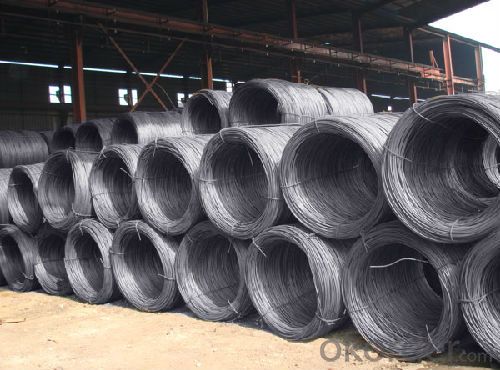
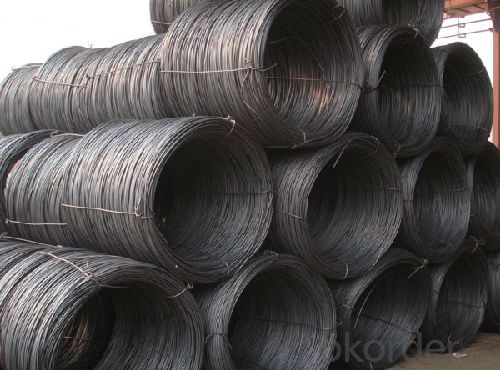
- Q: What are the different toughness testing methods for steel wire rod?
- There are several different toughness testing methods that can be used to assess the strength and durability of steel wire rods. Some of the commonly employed techniques are: 1. Charpy Impact Test: This method involves striking a notched specimen with a pendulum hammer and measuring the energy absorbed during fracture. It provides an indication of the material's resistance to impact loading and can be used to evaluate the ductile-to-brittle transition temperature. 2. Izod Impact Test: Similar to the Charpy test, the Izod method measures the energy absorbed by a notched specimen when struck by a swinging pendulum. This test is particularly useful for assessing the toughness of materials with low impact resistance. 3. Tensile Testing: This method involves subjecting a wire rod to a gradually increasing tensile force until it fractures. By measuring the maximum force applied and the elongation at fracture, the tensile strength and ductility of the steel can be determined. Although tensile testing does not directly measure toughness, it provides valuable information about the material's mechanical properties. 4. Bend Test: In this test, a steel wire rod is bent to a specified angle and inspected for signs of cracking or fracture. The ability of the material to withstand bending without failure is indicative of its toughness and ductility. 5. Hardness Testing: Hardness tests, such as the Rockwell or Brinell test, measure the resistance of a material to indentation. Although hardness is not a direct measure of toughness, it can provide an indication of the material's strength and ability to resist deformation. 6. Fracture Toughness Testing: This method involves measuring the critical stress intensity factor (KIC) or fracture toughness of a material. It provides information about how the material will behave under stress, including its resistance to crack propagation. Overall, these toughness testing methods help in evaluating the performance and suitability of steel wire rods for various applications, such as construction, manufacturing, and engineering. The choice of testing method depends on the specific requirements and characteristics of the material being assessed.
- Q: What are the main distribution channels for steel wire rod?
- The main distribution channels for steel wire rod include manufacturers, wholesalers, retailers, and e-commerce platforms. Manufacturers play a crucial role as they produce steel wire rod in various grades and sizes. They have their distribution networks to directly supply the product to wholesalers or retailers. These manufacturers often have their sales teams or agents who actively promote and sell their products to potential customers. Wholesalers are intermediaries who purchase large quantities of steel wire rod from manufacturers and then distribute it to retailers or other businesses. They typically have extensive networks and warehouses to store and transport the product efficiently. Wholesalers often offer competitive pricing and bulk discounts, making them an attractive option for retailers and businesses looking to buy steel wire rod in large quantities. Retailers are the final link in the distribution chain, selling steel wire rod directly to end consumers or small businesses. They can be specialized steel suppliers or hardware stores that carry a wide range of products. Retailers often provide convenient access to steel wire rod for customers who require smaller quantities or immediate availability. In recent years, the emergence of e-commerce platforms has significantly impacted the distribution of steel wire rod. Online marketplaces allow manufacturers, wholesalers, and retailers to reach a wider customer base and facilitate direct sales. E-commerce platforms provide convenience, quick delivery, and often offer competitive pricing, making it an increasingly popular choice for buyers. Overall, the main distribution channels for steel wire rod encompass a combination of traditional channels such as manufacturers, wholesalers, and retailers, as well as the growing prominence of e-commerce platforms in the industry.
- Q: What are the main factors affecting the market competition of steel wire rod?
- The main factors affecting the market competition of steel wire rod include the demand and supply dynamics, pricing strategies of competitors, technological advancements, government regulations, availability of raw materials, and the overall economic conditions. Additionally, factors like product quality, customer preferences, and brand reputation also play a significant role in determining the level of competition within the steel wire rod market.
- Q: What are the different surface defects that can impact the weldability of steel wire rod?
- Some common surface defects that can impact the weldability of steel wire rods include scale, rust, oil or grease contamination, and surface roughness. These defects can affect the quality and integrity of the weld, leading to weak or failed welds. Therefore, it is crucial to thoroughly clean and prepare the surface of the steel wire rod before welding to ensure a strong and durable weld joint.
- Q: How is steel wire rod used in the production of tire reinforcement materials for motorcycles?
- Steel wire rod is used in the production of tire reinforcement materials for motorcycles as it provides strength and durability. The steel wire rod is typically woven into a mesh or used as individual strands, which are then incorporated into the tire's structure to enhance its structural integrity and resistance to punctures and impacts. This reinforcement ensures that the motorcycle tires maintain their shape, grip the road effectively, and provide a safe and reliable riding experience.
- Q: What are the different types of steel wire rod surface treatment processes?
- There are several different types of steel wire rod surface treatment processes, including pickling, galvanizing, phosphating, electroplating, and powder coating.
- Q: How is steel wire rod used in the manufacturing of wire rope chains?
- Steel wire rod is used in the manufacturing of wire rope chains as it serves as the raw material for producing the individual wires that make up the chain. The steel wire rod is first drawn down to the desired diameter and then twisted together to form strands, which are further twisted around a core to create the final wire rope chain. The strength and durability of the steel wire rod ensures the chain's ability to bear heavy loads and withstand rigorous usage in various industries and applications.
- Q: What are the safety precautions to be taken while working with steel wire rod?
- When working with steel wire rods, there are several safety precautions that should be taken to minimize the risk of accidents or injuries. These include: 1. Personal Protective Equipment (PPE): Always wear appropriate PPE such as safety glasses, gloves, and steel-toed boots to protect yourself from potential hazards. In some cases, a hard hat may also be necessary. 2. Training: Ensure that all workers are properly trained on the safe handling and use of steel wire rods. This includes understanding the potential hazards, safe operating procedures, and emergency protocols. 3. Handling and storage: When handling steel wire rods, use proper lifting techniques and equipment to avoid strains or injuries. Store the rods in a designated area, away from walkways or high traffic areas, to prevent tripping or falling hazards. 4. Inspection: Regularly inspect steel wire rods for any defects, such as sharp edges, rust, or damage, as these can pose a safety risk. If any defects are found, replace the rods or repair them before further use. 5. Secure the work area: Ensure that the work area is clear of clutter, debris, or any other potential tripping hazards. Keep the floor dry and clean to prevent slips and falls while working with steel wire rods. 6. Use proper tools and equipment: Use appropriate tools and equipment for cutting, bending, or shaping steel wire rods. Ensure that the tools are in good working condition and are used correctly to prevent accidents. 7. Fire safety: Steel wire rods can generate sparks when cut or welded, so it is important to have fire prevention measures in place. Ensure that fire extinguishers are readily available in the work area and that workers are trained on how to use them. 8. Communication: Establish clear communication channels between workers to ensure that everyone is aware of the work being done and any potential hazards. Use appropriate signage or warning labels to indicate areas where steel wire rods are being used or stored. By following these safety precautions, the risk of accidents or injuries while working with steel wire rods can be significantly reduced, ensuring a safe working environment for all.
- Q: How is steel wire rod used in the manufacturing of wire forms for filtration systems?
- Steel wire rod is used in the manufacturing of wire forms for filtration systems as it serves as the raw material for creating various wire shapes and sizes. The wire rod is first processed through a series of steps, such as drawing and annealing, to achieve the desired mechanical properties and surface finish. Then, it is further transformed into wire forms, such as screens, meshes, and baskets, which are crucial components in filtration systems. These wire forms provide the necessary strength, durability, and precision required to effectively filter and separate particles or impurities from fluids or gases in different industrial processes.
- Q: How is steel wire rod used in the production of wire mesh for automotive applications?
- Steel wire rod is used in the production of wire mesh for automotive applications by being drawn through a series of dies to reduce its diameter and increase its length. This process, known as wire drawing, results in a thin and elongated wire that is then woven or welded to create wire mesh. The wire mesh is then utilized in various automotive applications such as reinforcing structures, providing protection, or acting as a filtration system.
Send your message to us
Hot Rolled Steel Wire Rod SAE1006 ou Q235 5.5MM-14MM
- Loading Port:
- Tianjin
- Payment Terms:
- TT or LC
- Min Order Qty:
- 25 m.t.
- Supply Capability:
- 100000 m.t./month
OKorder Service Pledge
OKorder Financial Service
Similar products
Hot products
Hot Searches
Related keywords
